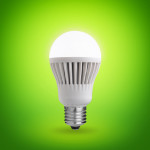Energy Efficiency Tips
 Having an energy efficient home means you’ll need a smaller PV system to offset your electric bill. It’s been estimated that every dollar spent on energy efficiency in the home or business saves approximately $20 on the cost of a PV system.
Having an energy efficient home means you’ll need a smaller PV system to offset your electric bill. It’s been estimated that every dollar spent on energy efficiency in the home or business saves approximately $20 on the cost of a PV system.
There are cost effective measures that can be taken to reduce your energy requirements, and many of them can be implemented with minimal impact on your lifestyle. It’s important to note that all of these solutions will pay for themselves in the long run. To maximize your savings consider consulting a “Energy Auditor” who can help you determine the most cost effective ways to reduce your energy use.
Inexpensive Solutions which make a Significant Difference!
 LED (Light Emitting Diode) Light Bulbs
LED (Light Emitting Diode) Light Bulbs
An LED bulb uses about 85% less electricity and can save you up to $250 in energy cost over the life of the bulb. Current models are compatible with all types of light fixtures including dimmers, and they can produce varying types of light including the warm glow of incandescents. LED’s typically last 50,000 hours while incandescent bulbs only last about 1,200 hours.
 Compact Fluorescent Light Bulbs (CFL’s)
Compact Fluorescent Light Bulbs (CFL’s)
A CFL bulb uses about 75% less electricity and can save you up to $50 in energy cost over the life of the bulb. Current models are compatible with all types of light fixtures, and they can produce varying types of light including the warm glow of incandescents. CFL’s typically last 8,000 hours while incandescent bulbs only last about 1,200 hours.
 Programmable Thermostats
Programmable Thermostats
Heating and cooling interior spaces uses a lot of energy. Installing a programmable thermostat can significantly reduce your utility costs by using less energy at times when you’re not home or at night when you’re sleeping. It is estimated that the proper use of a programmable thermostat can reduce your energy consumption by 10-20%.
 Phantom Loads
Phantom Loads
Many electronic devices consume power even when they are turned off, these are referred to as phantom loads. In some cases, such as cable boxes, the loan when the device is off can be just as high as when it’s actually in use. Although the energy draw is small for any single device, the combined draw for a building’s devices can be quite significant. Use power strips to conveniently turn off several electronic devices, thereby eliminating the constant energy draw.
Long Term Investments which make a Dramatic Difference!
 Attic Insulation
Attic Insulation
A large amount of energy, and thus money, is lost through improperly insulated attics. Adding insulation to the attic, up to the recommended R30 value, is relatively easy and is very cost effective..
 Sealed Doors and Windows
Sealed Doors and Windows
Air infiltration can account for 30% a home’s heating and cooling costs. Ensuring that there are no leaks in doors and windows can significantly reduce your utility bills. Consider weather stripping doors and replacing old and drafty windows with new double or triple paned high efficiency models.
 Energy Star Appliances
Energy Star Appliances
Energy Star is a government-backed program helping businesses and homeowners protect the environment through superior energy efficiency. Appliances with this label exceed minimum federal standards, and the increased cost of the more efficient appliance pays for itself through energy savings.


